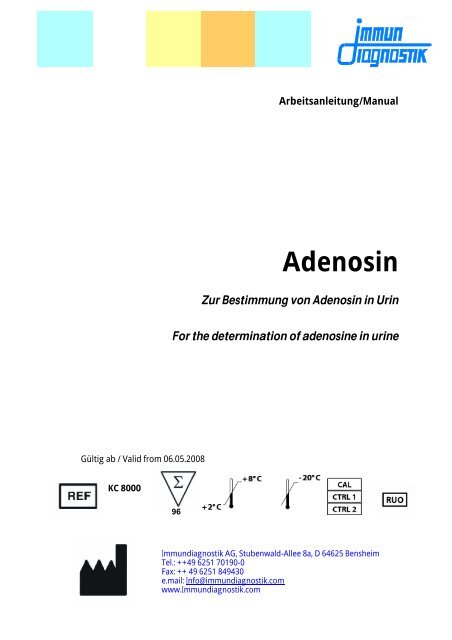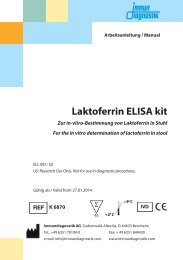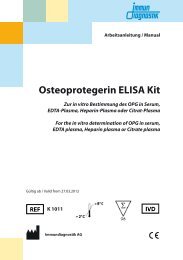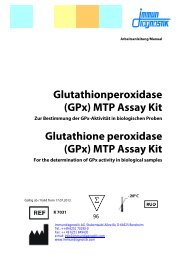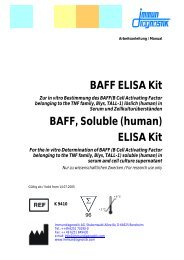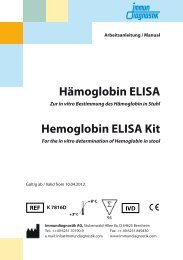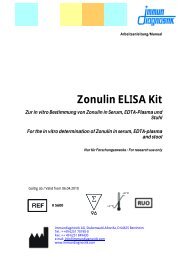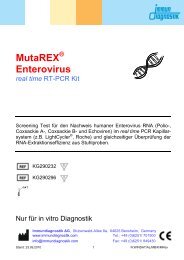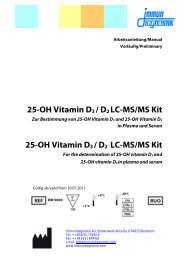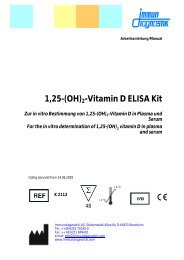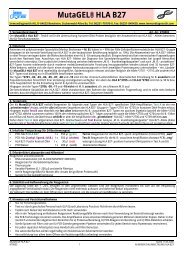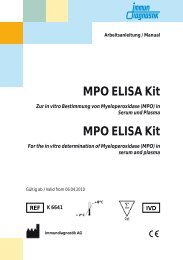HPLC-Analytik Adenosin - Labodia
HPLC-Analytik Adenosin - Labodia
HPLC-Analytik Adenosin - Labodia
Sie wollen auch ein ePaper? Erhöhen Sie die Reichweite Ihrer Titel.
YUMPU macht aus Druck-PDFs automatisch weboptimierte ePaper, die Google liebt.
Gültig ab / Valid from 06.05.2008<br />
KC 8000<br />
96<br />
Arbeitsanleitung/Manual<br />
<strong>Adenosin</strong><br />
Zur Bestimmung von <strong>Adenosin</strong> in Urin<br />
For the determination of adenosine in urine<br />
Immundiagnostik AG, Stubenwald-Allee 8a, D 64625 Bensheim<br />
Tel.: ++49 6251 70190-0<br />
Fax: ++ 49 6251 849430<br />
e.mail: Info@immundiagnostik.com<br />
www.Immundiagnostik.com
<strong>HPLC</strong>-<strong>Analytik</strong> <strong>Adenosin</strong><br />
Inhaltsverzeichnis/Table of contents<br />
Seite/Page<br />
1. VERWENDUNGSZWECK 3<br />
2. EINLEITUNG 3<br />
3. TESTPRINZIP 4<br />
4. INHALT DER TESTPACKUNG 5<br />
5. ERFORDERLICHE LABORGERÄTE UND HILFSMITTEL: 5<br />
6. VORBEREITUNG UND LAGERUNG DER REAGENZIEN 6<br />
7. HINWEISE UND VORSICHTSMAßNAHMEN 6<br />
8. PROBENVORBEREITUNG 6<br />
9. TESTDURCHFÜHRUNG 6<br />
HINWEISE 6<br />
ARBEITSSCHEMA 7<br />
CHROMATOGRAPHISCHE BEDINGUNGEN 8<br />
10. BEHANDLUNG DER TRENNSÄULE 8<br />
11. AUSWERTUNG 9<br />
BERECHNUNG 9<br />
MUSTERCHROMATOGRAMM 9<br />
12. EINSCHRÄNKUNGEN 9<br />
13. QUALITÄTSKONTROLLE 10<br />
NORMBEREICH 10<br />
KONTROLLEN 10<br />
14. TESTCHARAKTERISTIKA 10<br />
PRÄZISION UND REPRODUZIERBARKEIT 10<br />
LINEARITÄT 10<br />
NACHWEISGRENZE 10<br />
15. ENTSORGUNG 10<br />
16. MAßNAHMEN BEI STÖRUNGEN 11<br />
17. LITERATUR 12<br />
18. ALLGEMEINE HINWEISE ZUM TEST 13<br />
1
<strong>HPLC</strong>-<strong>Analytik</strong> <strong>Adenosin</strong><br />
1. INTENDED USE 14<br />
2. INTRODUCTION 14<br />
3. PRINCIPLE OF THE TEST 15<br />
4. MATERIAL SUPPLIED 16<br />
5. MATERIAL REQUIRED BUT NOT SUPPLIED 16<br />
6. PREPARATION AND STORAGE OF REAGENTS 17<br />
7. PRECAUTIONS 17<br />
8. SPECIMEN COLLECTION AND PREPARATION 17<br />
9. ASSAY PROCEDURE 17<br />
PROCEDURAL NOTES 17<br />
ASSAY PROCEDURE 18<br />
CHROMATOGRAPHIC CONDITIONS 19<br />
10. TREATMENT OF THE COLUMN 19<br />
11. RESULTS 20<br />
CALCULATION 20<br />
TYPICAL CHROMATOGRAM 20<br />
12. LIMITATIONS 20<br />
13. QUALITY CONTROL 21<br />
EXPECTED VALUES 21<br />
CONTROLS 21<br />
14. PERFORMANCE CHARACTERISTICS 21<br />
PRECISION AND REPRODUCIBILITY 21<br />
LINEARITY 21<br />
DETECTION LIMIT 21<br />
15. DISPOSAL 21<br />
16. TROUBLESHOOTING 22<br />
17. REFERENCES 23<br />
18. GENERAL NOTES ON THE TEST AND TEST PROCEDURE 24<br />
2
<strong>HPLC</strong>-<strong>Analytik</strong> <strong>Adenosin</strong><br />
1. VERWENDUNGSZWECK<br />
Der <strong>HPLC</strong>-Kit ist für die Bestimmung von <strong>Adenosin</strong> aus Urin geeignet. Nur<br />
zur in vitro Diagnostik.<br />
2. EINLEITUNG<br />
<strong>Adenosin</strong> ist ein ubiquitäres, biologisch wichtiges Nucleosid und Vorläufer<br />
anderer ähnlicher biologisch aktiver Moleküle. <strong>Adenosin</strong> ist Bestandteil<br />
verschiedener Kofaktoren, kann jedoch auch selbst biologisch aktiv sein: Es<br />
spielt eine wichtige Rolle im zentralen Nervensystem, im kardiovaskulären<br />
System, in der Skelettmuskulatur und im Immunsystem.<br />
Zu den wichtigen eigenständigen intrazellulären Wirkungen von <strong>Adenosin</strong><br />
gehört die Hemmung des Enzyms Phosphodiesterase. Extrazelluläres<br />
<strong>Adenosin</strong> zeigt eine spezifische neuromodulatorische Wirkung auf Dopamin<br />
und Glutamat.<br />
<strong>Adenosin</strong> wirkt entweder als Hormon indem es an spezifische Rezeptoren<br />
auf der Zellmembran bindet oder als intrazellulärer Modulator nach dem<br />
Transport in die Zelle mit Hilfe von Membrantransportproteinen. Vier<br />
<strong>Adenosin</strong>-Rezeptor-Subtypen sind beschrieben. Besonders häufig treten<br />
<strong>Adenosin</strong>-Rezeptoren im Gehirn und im kardiovaskulären System auf. Sie<br />
kommen aber auch in den meisten anderen Geweben vor, z. B. in<br />
Respirationsapparat, Darm, Niere, Muskulatur, Hypophyse, Uterus und<br />
Gonaden. Durch Aktivierung der spezifischen Zelloberflächenrezeptoren<br />
induziert <strong>Adenosin</strong> eine Reihe physiologischer Effekte. Des Weiteren<br />
fungiert <strong>Adenosin</strong> als endogener Regulator von Immun- und Entzündungsvorgängen.<br />
<strong>Adenosin</strong> zeigt vielfältige Wirkungen auf das Herz und die Blutgefäße und<br />
ist an der Regulation der Nierenfunktion beteiligt. Es spielt eine wichtige<br />
Rolle für den Schutz der Körpergewebe, besonders im Zustand einer<br />
Hypoxie oder Ischämie, Exzitotoxizität, einer durch andere Substanzen<br />
induzierten Toxizität und Trauma. Aufgrund seiner wichtigen elektrophysiologischen<br />
Eigenschaft, die Reizleitung zwischen Vorhof und atrioventrikulären<br />
Knoten zu verlangsamen, wird <strong>Adenosin</strong> auch als ein<br />
effektives und sicheres Medikament für die Behandlung paroxysmaler<br />
Tachykardien bei Erwachsenen und Kindern verwendet.<br />
Die Messung von <strong>Adenosin</strong> im Urin kann zur Evaluierung von Nierenschäden,<br />
metabolischen Erkrankungen und schwerer Lungeninsuffizienz<br />
eingesetzt werden, da es nachgewiesen ist, dass erhebliche pathophysiologische<br />
Zustände mit einem erhöhten <strong>Adenosin</strong>-Spiegel<br />
einhergehen.<br />
Indikationen<br />
• Evaluierung von Nierenschäden<br />
• Metabolische Erkrankungen<br />
3
<strong>HPLC</strong>-<strong>Analytik</strong> <strong>Adenosin</strong><br />
3. TESTPRINZIP<br />
Die <strong>HPLC</strong>-Trennung von <strong>Adenosin</strong> erfolgt durch Anlegen eines Gradienten<br />
aus Laufmittel A und B bei 30°C auf einer reversed-phase-Säule. Für einen<br />
Lauf werden ca. 35 Minuten benötigt. Die Aufnahme der Chromatogramme<br />
erfolgt mit einem UV-Detektor. Die Quantifizierung wird über den<br />
mitgelieferten Kalibrator und die Berechnung der Ergebnisse über die<br />
externe Standard-Methode anhand der Integration der Peakhöhen durchgeführt.<br />
Es sollte parallel eine Kreatinin-Bestimmung des Urins durchgeführt<br />
werden, um die Ergebnisse der <strong>HPLC</strong>-Messung zu normieren.<br />
Zusammenfassung<br />
Der hier vorliegende <strong>HPLC</strong>-Kit ermöglicht eine einfache, schnelle und<br />
präzise quantitative Bestimmung des <strong>Adenosin</strong>s. Der Kit enthält gebrauchsfertige<br />
Reagenzien und Verbrauchsmaterialien für die analytische <strong>HPLC</strong>-<br />
Trennung. Die Trennsäule (KC8000RP), Vorsäulen (KC8000VS) sowie der für<br />
die Probenaufarbeitung erforderliche <strong>Adenosin</strong>-Extraktionskit (KC8100) zur<br />
Extraktion von <strong>Adenosin</strong> aus Urin können separat über die Firma Immundiagnostik<br />
erworben werden. Das Extraktionskit enthält gebrauchsfertige<br />
Reagenzien und Verbrauchsmaterialien zur Aufarbeitung von 48 Urinproben<br />
(Extraktionsplatte, Extraktionspuffer, Elutionslösung). Bitte beachten Sie:<br />
um die Kapazität des <strong>Adenosin</strong>-<strong>HPLC</strong>-Kits von 96 Proben voll auszuschöpfen<br />
benötigen Sie 2 Extraktionskits.<br />
Dieser <strong>HPLC</strong>-Kit ermöglicht auch Laboratorien, die bislang noch keine<br />
Erfahrung mit Hochdruckflüssigkeitschromatographie haben, diese Technik<br />
schnell und problemlos für klinisch-chemische Routinezwecke einzusetzen.<br />
Für die Kalibrierung des Testsystems ist meist eine Einpunkt-Kalibrierung<br />
ausreichend. Eine Automatisierung der Probenaufgabe und der Auswertung<br />
ist möglich, so dass auch größere Probenzahlen fast unbeaufsichtigt<br />
abgearbeitet werden können.<br />
4
<strong>HPLC</strong>-<strong>Analytik</strong> <strong>Adenosin</strong><br />
4. INHALT DER TESTPACKUNG<br />
Artikel Nr. Inhalt Kit Komponenten Menge<br />
KC8000LA MOPHAA Laufmittel A 4 x 1000 ml<br />
KC8000LB MOPHAB Laufmittel B 1 x 1000 ml<br />
KC8000ST STAB Stabilisierungsreagenz 1,5 ml<br />
KC8000RE RECSOL Rekonstitutionslösung 20 ml<br />
KC8000KA CAL Kalibrator (lyoph., 6 ml) 2 Flaschen<br />
KC8000KO CTRL 1<br />
CTRL 2<br />
Kontrolle 1 und 2 (lyoph., 600 µl,<br />
Konzentration, siehe Spezifikation)<br />
5<br />
2 x 3<br />
Fläschchen<br />
Die <strong>HPLC</strong> Trennsäule (KC8000RP), die Vorsäulen (KC8000VS) sowie der für die Probenaufarbeitung<br />
erforderliche <strong>Adenosin</strong>-Extraktionskit (KC8100) zur Extraktion von <strong>Adenosin</strong> aus<br />
Urin können separat bei Immundiagnostik bestellt werden. Ein Extraktionskit ist<br />
ausreichend für 48 Proben und beinhaltet eine Extraktionsplatte mit 48 Vertiefungen,<br />
Extraktionspuffer und Elutionslösung für 48 Proben. Bitte beachten Sie: Um die Kapazität<br />
des <strong>Adenosin</strong>-<strong>HPLC</strong>-Kits von 96 Proben voll auszuschöpfen benötigen Sie 2 Extraktionskits.<br />
Neben den kompletten Kits können auch alle Komponenten einzeln bestellt werden.<br />
Bitte fordern Sie unsere Einzelkomponentenpreisliste an.<br />
5. ERFORDERLICHE LABORGERÄTE UND HILFSMITTEL:<br />
• Vortex Wirbelmischer<br />
• 1,5 ml Reaktionsgefäße (z.B. Eppendorf)<br />
• Diverse Pipetten<br />
• Aqua bidest.<br />
• Horizontalschüttler<br />
• <strong>HPLC</strong> Gradientenanlage mit UV-Detektor<br />
• Zentrifuge<br />
• Reversed phase-Säule Nucleosil 100 C18 125 x 4 mm, 10 µm (KC8000RP)<br />
• Vorsäulenkartuschen Nucleosil 100 C18 10 x 4 mm, 10 µm (KC8000VS)<br />
• <strong>Adenosin</strong>-Extraktionskit (KC8100) zur Extraktion von <strong>Adenosin</strong> aus Urin
<strong>HPLC</strong>-<strong>Analytik</strong> <strong>Adenosin</strong><br />
6. VORBEREITUNG UND LAGERUNG DER REAGENZIEN<br />
• Die Testreagenzien sind bei 2-8°C, der Kalibrator (CAL) und die<br />
Kontrollen (CTRL) bei -20°C bis zum Verfallsdatum (siehe Etikett)<br />
verwendbar.<br />
• Der Kalibrator (CAL) wird mit 6 ml der im Kit enthaltenen Rekonstitutionslösung<br />
(RECSOL) oder aqua bidest. resuspendiert. Der rekonstituierte<br />
Kalibrator ist bei -20°C bis zum Verfallsdatum (siehe Etikett) haltbar.<br />
• Die Kontrollen (CTRL1, 2) werden mit je 600 µl der im Kit enthaltenen<br />
Rekonstitutionslösung (RECSOL) oder aqua bidest. resuspendiert.<br />
• Kalibrator (CAL) und Kontrollen (CTRL1, 2) enthalten bereits Stabilisierungsreagenz<br />
und bedürfen keiner weiteren Stabilisierung.<br />
• Die übrigen Testreagenzien werden gebrauchsfertig in gelöster Form<br />
geliefert.<br />
7. HINWEISE UND VORSICHTSMAßNAHMEN<br />
• Nur zur in vitro Diagnostik<br />
• Die Reagenzien dürfen nach Ablauf des Mindesthaltbarkeitsdatums nicht<br />
mehr verwendet werden.<br />
8. PROBENVORBEREITUNG<br />
Als Probe eignet sich Morgenurin, der sofort nach Abgabe mit<br />
Stabilisierungsreagenz (STAB) versetzt wird. Hierfür werden zu 500 µl Urin<br />
10 µl STAB (Stabilisierungsreagenz) pipettiert. Durch die Zugabe des<br />
Stabilisierungsreagenz kann es zu Präzipitationen kommen. Die Proben<br />
sollten vor dem Testansatz zentrifugiert werden (siehe Arbeitsschema) und<br />
der resultierende Überstand im Test eingesetzt werden. Die stabilisierte<br />
Probe ist bei -20°C mindestens 6 Monate stabil.<br />
Nach dem Auftauen der Proben sollte schnellstmöglich die Analyse<br />
erfolgen.<br />
9. TESTDURCHFÜHRUNG<br />
Hinweise<br />
• Qualitätskontrollen sollten immer mitgemessen werden.<br />
• Inkubationszeit, Temperatur und Pipettiervolumina sind vom Hersteller<br />
festgelegt. Jegliche Abweichung der Testvorschrift, die nicht mit dem<br />
Hersteller koordiniert wurde, kann zu fehlerhaften Ergebnissen führen.<br />
Immundiagnostik AG übernimmt keine Haftung.<br />
• Der Assay ist immer nach der im Kit beigefügten Arbeitsanleitung<br />
abzuarbeiten.<br />
6
<strong>HPLC</strong>-<strong>Analytik</strong> <strong>Adenosin</strong><br />
Arbeitsschema<br />
Die stabilisierten Proben, der CAL (Kalibrator) und die CTRL 1, CTRL 2<br />
(Kontrolle 1, Kontrolle 2) müssen vor Testeinsatz 10 Minuten bei 10000 rpm<br />
zentrifugiert werden und der resultierende Überstand im Test eingesetzt<br />
werden.<br />
In jeweils ein well der Extraktionsplatte werden pipettiert:<br />
450 µl Probe, CAL (Kalibrator) oder CTRL1, 2 (Kontrolle 1, 2)<br />
+<br />
50 µl EXBUF (Extraktionspuffer)<br />
Extraktionplatte mit einer Folie abkleben und 30 Minuten auf einem<br />
Horizontalschüttler bei Raumtemperatur inkubieren.<br />
Folie entfernen, Platte ausleeren und Flüssigkeitsreste durch kräftiges<br />
Ausklopfen auf einer saugfähigen Unterlage (Papierhandtuch) entfernen.<br />
1 ml aqua bidest. in jedes well pipettieren, Exktraktionsplatte mit Folie<br />
abkleben und 5 Minuten auf dem Horizontalschüttler bei Raumtemperatur<br />
inkubieren.<br />
Folie entfernen, Platte ausleeren und Flüssigkeitsreste durch kräftiges<br />
Ausklopfen auf einer saugfähigen Unterlage (Papierhandtuch) entfernen.<br />
200 µl ELUSOL (Elutionslösung) in jedes well pipettieren, Exktraktionsplatte<br />
mit Folie abkleben und 10 Minuten auf dem Horizontalschüttler bei<br />
Raumtemperatur inkubieren.<br />
Den kompletten Inhalt jedes wells in je ein 1,5 ml Reaktionsgefäß<br />
pipettieren und 10 Minuten bei 10000 rpm zentrifugieren.<br />
Der Überstand ist als Probe jetzt mindestens 24 Stunden bei 4 °C stabil.<br />
100 µl in das <strong>HPLC</strong>-System injizieren.<br />
7
<strong>HPLC</strong>-<strong>Analytik</strong> <strong>Adenosin</strong><br />
Chromatographische Bedingungen<br />
Säulenmaterial: Nucleosil 100 C18, 10 µm<br />
Säulendimension: 125 mm x 4 mm<br />
Fluss : 1,0 ml/min<br />
UV-Detektion: 254 nm<br />
Temperatur: 30 °C<br />
Injektionsvolumen: 100 µl<br />
Laufzeit pro Chromatogramm: 35 Minuten<br />
Gradient: 0 min (100 % A / 0 % B)<br />
12 min (100 % A / 0 % B)<br />
24 min (60 % A / 40 % B)<br />
26 min (0 % A / 100 % B)<br />
28 min (0 % A / 100 % B)<br />
29 min (100 % A / 0 % B)<br />
35 min (100 % A / 0 % B)<br />
Wir empfehlen dringend die Verwendung einer Vorsäule um die<br />
Säulenhaltbarkeit zu verlängern.<br />
10. BEHANDLUNG DER TRENNSÄULE<br />
Nach der Analyse sollte die Trennsäule mit ca. 50 ml Aqua bidest. bei einem<br />
Fluss von 1 ml/min gespült werden. Anschließend wird die Säule in 85%<br />
Acetonitril / 15% Wasser gelagert (ca. 30 ml, Fluss 1,0 ml/min).<br />
Zur Wiederinbetriebnahme wird das ganze System mit ca. 30 ml Laufmittel<br />
A (MOPHAA) äquilibriert.<br />
8
<strong>HPLC</strong>-<strong>Analytik</strong> <strong>Adenosin</strong><br />
11. AUSWERTUNG<br />
Berechnung<br />
Konzentration Probe =<br />
Musterchromatogramm<br />
Peakhöhe Probe x Konzentration des Kalibrators<br />
Peakhöhe Kalibrator<br />
Die Ergebnisse der <strong>HPLC</strong>-Auswertung sollten anhand der Kreatinin-<br />
Konzentration des Urins normiert werden.<br />
12. EINSCHRÄNKUNGEN<br />
Blutproben können nicht bestimmt werden.<br />
9
<strong>HPLC</strong>-<strong>Analytik</strong> <strong>Adenosin</strong><br />
13. QUALITÄTSKONTROLLE<br />
Normbereich<br />
Bereich in Urin 0,78 – 6,84 µM (Mittelwert: 2,51µM)<br />
Bereich bezogen auf Kreatinin 0,07 – 0,63 µM/mM Kreatinin<br />
(Mittelwert: 0,26 µM/mM Kreatinin)<br />
Wir empfehlen jedem Labor seinen eigenen Normalwerte-Bereich zu<br />
erstellen, weil Referenzbereiche stark von der Auswahl des Probandenkollektivs<br />
abhängig sind. Die Angabe des Normalbereichs dient lediglich der<br />
Orientierung und kann von anderen publizierten Daten abweichen.<br />
Kontrollen<br />
Zur Überwachung der Qualität der Analyse sollten bei jedem Lauf Kontrollen<br />
mitgeführt werden. Wenn eine oder mehrere Kontrollen eines Laufs<br />
außerhalb ihres Bereichs liegen ist es möglich, dass auch die<br />
Patientenproben falsch ermittelt wurden.<br />
14. TESTCHARAKTERISTIKA<br />
Präzision und Reproduzierbarkeit<br />
Intra-Assay VK: 4,7 % [n = 6]<br />
Inter-Assay VK: 12,8 % [n = 6]<br />
Linearität<br />
Nachweisgrenze<br />
15. ENTSORGUNG<br />
bis 1000 µM<br />
0,42 µM<br />
Die Laufmittel (MOPHAA und MOPHAB) müssen als halogenfreier<br />
Lösungsmittelabfall entsorgt werden.<br />
10
<strong>HPLC</strong>-<strong>Analytik</strong> <strong>Adenosin</strong><br />
16. MAßNAHMEN BEI STÖRUNGEN<br />
Problemstellung Mögliche Ursache Behebung<br />
Kein Signal Keine oder defekte<br />
Verbindung zur<br />
Auswerteeinheit.<br />
11<br />
Signalkabel und<br />
Anschluss prüfen.<br />
Detektorlampe zu alt Ggf. Lampe erneuern<br />
Keine Peaks Injektor verstopft Injektor überprüfen<br />
Doppelpeaks Totvolumen an Fittings Fittings und / oder Säule<br />
und / oder Säule erneuern<br />
Störpeaks Injektor verunreinigt Injektor reinigen<br />
Kontamination am<br />
Säulenkopf<br />
Säule umdrehen und 30<br />
min mit niedrigem Fluss<br />
(0,2 ml/min) Laufmittel<br />
spülen<br />
Luft im System Pumpe entgasen<br />
Autosamplergefäße<br />
verunreinigt<br />
Neue oder mit Methanol<br />
gespülte<br />
Autosamplergefäße<br />
verwenden<br />
Breite Peaks, Tailing Vorsäule / Säule zu alt Neue Vorsäule / Säule<br />
verwenden<br />
Veränderte<br />
Retentionszeit<br />
Temperaturdrift Säulenofen verwenden<br />
Pumpe fördert ungenau Pumpe überprüfen,<br />
entlüften<br />
System noch nicht im<br />
Gleichgewicht<br />
Basislinie driftet Detektorlampe<br />
kalt<br />
noch<br />
System mit mobiler<br />
Phase 15 min spülen<br />
Warten<br />
Detektorlampe zu alt Ggf. Lampe erneuern<br />
System noch nicht im<br />
Gleichgewicht<br />
System mit mobiler<br />
Phase 15 min spülen<br />
Pumpe fördert ungenau Pumpe überprüfen,<br />
entlüften
<strong>HPLC</strong>-<strong>Analytik</strong> <strong>Adenosin</strong><br />
Problemstellung Mögliche Ursache Behebung<br />
Unruhige Basislinie Pumpe fördert ungenau Pumpe überprüfen,<br />
entlüften<br />
Detektorzelle<br />
verschmutzt<br />
Detektorzelle reinigen<br />
17. LITERATUR<br />
1. Baggott JE, Morgan SL, Sams WM, Linden J. (1999) Urinary adenosine and<br />
aminoimidazolecarboxamide excretion in methotrexate-treated patients<br />
with psoriasis. Arch Dermatol. Jul;135(7):813-7<br />
2. Berne RM. (1980) The role of adenosine in the regulation of coronary<br />
blood flow. Circ Res. 68:807-13<br />
3. Deussen A, Flesche CW, Lauer T, Sonntag M, Schrader J. (1996) Spatial<br />
heterogeneity of blood flow in dog heart. II. Temporal stability in<br />
response to adrenergic stimulation. Pfluegers Arch. 432:451-61<br />
4. Engler RL (1991) <strong>Adenosin</strong>e. The signal of life? Circulation 84:951-954<br />
5. Heyne N, Benöhr P, Mühlbauer B, Delabar U, Risler T, Osswald H. (2004)<br />
Regulation of renal adenosine excretion in humans--role of sodium and<br />
fluid homeostasis. Nephrol Dial Transplant. Nov;19(11):2737-41<br />
6. Katholi RE, Taylor GJ, McCann WP, Woods WT Jr, Womack KA, McCoy CD,<br />
Katholi CR, Moses HW, Mishkel GJ, Lucore CL, et al. (1995) Nephrotoxicity<br />
from contrast media: attenuation with theophylline. Radiology,<br />
Apr;195(1):17-22<br />
7. Müller CE, Scior T. (1993) <strong>Adenosin</strong>e receptors and their modulators.<br />
Review. Pharma Acta Helv. 68:77-111<br />
8. Osswald H. (1984) The role of adenosine in the regulation of glomerular<br />
filtration rate and renin secretion. Trends Pharmacol Sci. 5:94-7<br />
9. Taniai H, Sumi S, Ito T, Ueta A, Ohkubo Y, Togari H. (2006) A simple<br />
quantitative assay for urinary adenosine using column-switching highperformance<br />
liquid chromatography. Tohoku J Exp Med. Jan;208(1):57-63<br />
12
<strong>HPLC</strong>-<strong>Analytik</strong> <strong>Adenosin</strong><br />
18. ALLGEMEINE HINWEISE ZUM TEST<br />
• Dieser Kit wurde nach der IVD Richtlinie 98/79/EG hergestellt und in den<br />
Verkehr gebracht.<br />
• Reagenzien dieser Testpackung enthalten organische Lösungsmittel.<br />
Berührungen mit der Haut oder den Schleimhäuten sind zu vermeiden.<br />
• Sämtliche in der Testpackung enthaltene Reagenzien dürfen ausschließlich<br />
zur in-vitro-Diagnostik eingesetzt werden.<br />
• Die Reagenzien sollten nach Ablauf des Verfallsdatums nicht mehr<br />
verwendet werden (Verfallsdatum siehe Testpackung).<br />
• Einzelkomponenten mit unterschiedlichen Lot-Nummern aus<br />
verschiedenen Testpackungen sollten nicht gemischt oder ausgetauscht<br />
werden.<br />
• Für die Qualitätskontrolle sind die dafür erstellten Richtlinien für<br />
medizinische Laboratorien zu beachten.<br />
• Die charakteristischen Testdaten wie Pipettiervolumina der verschiedenen<br />
Komponenten und der Aufbereitung der Proben wurden firmenintern<br />
festgelegt. Nicht mit dem Hersteller abgesprochene Veränderungen in der<br />
Testdurchführung können die Resultate beeinflussen. Die Firma<br />
Immundiagnostik AG übernimmt für direkt daraus resultierende Schäden<br />
und Folgeschäden keine Haftung.<br />
13
Valid from 06.05.2008<br />
KC 8000<br />
96<br />
Manual<br />
<strong>Adenosin</strong><br />
For the determination of adenosine in urine
<strong>HPLC</strong>-<strong>Analytik</strong> <strong>Adenosin</strong><br />
1. INTENDED USE<br />
The present <strong>HPLC</strong> kit is designed for quantitative determination of<br />
adenosine in urine. It is for in vitro diagnostic use only.<br />
2. INTRODUCTION<br />
<strong>Adenosin</strong>e is a ubiquitous, biologically important nucleoside which is a<br />
precursor of other biologically active molecules as well as a component of<br />
some co-factors. Moreover, it also has its own distinct physiological<br />
functions in the central nervous system, the cardiovascular system, the<br />
skeletal muscle and the immune system.<br />
One of the principal intracellular actions of adenosine is inhibition of the<br />
enzyme phosphodiesterase. Extracellular adenosine has specific neuromodulatory<br />
actions on dopamine and glutamate.<br />
<strong>Adenosin</strong>e can act either as a hormone by binding to adenosine receptors or<br />
as an intracellular modulator after its translocation into the cell by<br />
membrane transport proteins. Four adenosine receptor subtypes have been<br />
identified. Notably, adenosine receptors are most widely expressed in the<br />
brain and the cardiovascular system, but they also are found in the most of<br />
the other tissues: respiratory tract, intestine, kidney, skeletal muscle,<br />
pituitary gland, uterus and gonads. <strong>Adenosin</strong>e modulates several<br />
physiological effects by stimulating specific cell surface receptors. In<br />
addition, adenosine acts as an endogenous regulator of immune and<br />
inflammatory processes.<br />
<strong>Adenosin</strong>e exerts multifaceted effects on the heart and blood vessels and is<br />
involved in the regulation of the renal function. It works as a universal<br />
protective agent against hypoxia, ischemia, excitotoxicity, toxicities induced<br />
by other substances and trauma. It is also an effective and safe therapeutic<br />
medicine for paroxysmal tachycardias in adult and pediatric patients, with<br />
basic electrophysiologic properties of slowing conduction in atrioventricular<br />
nodes.<br />
The measurement of urinary adenosine can contribute to evaluation of renal<br />
injury, metabolic disease or severe respiratory failure, as it was found that<br />
unfavorable pathophysiologic conditions are associated with appreciable<br />
elevation of adenosine.<br />
Indications<br />
• Evaluation of renal injury<br />
• Metabolic diseases<br />
14
<strong>HPLC</strong>-<strong>Analytik</strong> <strong>Adenosin</strong><br />
3. PRINCIPLE OF THE TEST<br />
The <strong>HPLC</strong> separation of adenosine is performed on a reversed phase column<br />
by the application of a gradient formed from solvent A and solvent B at<br />
30°C. The duration of one run is about 35 minutes. The chromatograms are<br />
recorded by a UV-detector. The quantification is based on integration of the<br />
peak heights of the sample and the provided calibrator as an external<br />
standard. Parallel measurements of the urinary creatinine concentration are<br />
required to normalize the <strong>HPLC</strong>-adenosine results.<br />
Summary<br />
The application of <strong>HPLC</strong> for adenosine analysis allows its quantification in an<br />
easy, fast, and precise way. Beside the column, the kit contains all reagents<br />
necessary for sample preparation and <strong>HPLC</strong> separation in ready-to-use form.<br />
The analytical column (KC8000RP), pre-column (KC8000VS) as well as the<br />
adenosine extraction kit (KC8100) necessary for adenosine extraction from<br />
urine can be ordered separately from Immundiagnostik. The extraction kit<br />
contains ready-to-use reagents and consumables for sample preparation of<br />
48 urine samples (extraction plate, extraction buffer, elution solution). Note:<br />
to use the complete capacity of the adenosine <strong>HPLC</strong> kit, which is designed<br />
for 96 samples, 2 extraction kits are needed.<br />
The present <strong>HPLC</strong> kit enables even laboratories without experience in high<br />
performance liquid chromatography to use this technique for clinical<br />
routine determination in a quick and precise manner. In addition, mostly<br />
one-point is sufficient to calibrate the test system. It is possible to automate<br />
the sample application and calculation of the results, so that even higher<br />
number of samples can be handled nearly without control.<br />
15
<strong>HPLC</strong>-<strong>Analytik</strong> <strong>Adenosin</strong><br />
4. MATERIAL SUPPLIED<br />
Cat. No Content Kit Components Quantity<br />
KC8000LA MOPHAA Mobile phase A 4 x 1000 ml<br />
KC8000LB MOPHAB Mobile phase B 1 x 1000 ml<br />
KC8000ST STAB Stabilizing reagent 1.5 ml<br />
KC8000RE RECSOL Reconstitution solution 20 ml<br />
KC8000KA CAL Calibrator (6 ml; lyophilized) 2 vials<br />
KC8000KO CTRL 1<br />
CTRL 2<br />
Control 1 and 2 (lyophilized, 600 µl;<br />
concentration, see product data sheet)<br />
16<br />
2 x 3 vials<br />
The analytical column (KC8000RP), pre-column (KC8000VS) as well as the adenosine<br />
extraction kit (KC8100) necessary for adenosine extraction from urine can be ordered<br />
separately from Immundiagnostik. The extraction kit contains ready-to-use reagents and<br />
consumables for sample preparation of 48 urine samples (extraction plate, extraction<br />
buffer, elution solution). Note: to use the complete capacity of the adenosine <strong>HPLC</strong> kit,<br />
which is designed for 96 samples, 2 extraction kits are needed.<br />
5. MATERIAL REQUIRED BUT NOT SUPPLIED<br />
• Vortex- mixer<br />
• 1.5 ml centrifugation tubes (e.g. Eppendorf)<br />
• Various pipettes<br />
• Aqua bidist.<br />
• Horizontal Shaker<br />
• <strong>HPLC</strong> gradient pump system with UV-detector<br />
• Centrifuge<br />
• Reversed phase column Nucleosil 100 C 18 125 x 4 mm, 10 µm (KC8000RP)<br />
• Pre-column cartridges Nucleosil 100 C 18 10 x 4 mm ,10 µm (KC8000VS)<br />
• <strong>Adenosin</strong>e extraction kit (KC8100) for adenosine extraction from urine
<strong>HPLC</strong>-<strong>Analytik</strong> <strong>Adenosin</strong><br />
6. PREPARATION AND STORAGE OF REAGENTS<br />
• All reagents are stable at 2-8 °C, calibrator (CAL) and controls (CTRL1,<br />
CTRL2) at -20 °C up to the date of expiry (see label of the test package).<br />
• Reconstitute the calibrator (CAL) with 6 ml of the reconstitution solution<br />
(RECOSOL) from the kit or with aqua bidist. The reconstituted standard<br />
solution is stable at -20 °C up to the date of expiry (see label of the test<br />
package).<br />
• Reconstitute the controls (CTRL1, CTRL2) with 600 µl of the reconstitution<br />
solution (RECOSOL) from the kit or with aqua bidist.<br />
• The calibrator (CAL) and the controls (CTRL1, CTRL2) contain already<br />
stabilizing reagent and do not need any further stabilization.<br />
• All other reagents are provided in ready-to-use form.<br />
7. PRECAUTIONS<br />
• For in vitro diagnostic use only.<br />
• Reagents should not be used beyond the expiration date shown on kit<br />
label.<br />
8. SAMPLE COLLECTION AND PREPARATION<br />
Morning urine is suited for this test. Immediately after urine collection, 10 µl<br />
STAB (stabilizing reagent) should be added to 500 µl of urine sample. The<br />
addition of the stabilizing reagent can cause precipitation. The samples<br />
should be centrifuged before analysis (see Assay procedure). The resulting<br />
supernatant is used in the test. The stabilized samples are stable for at least<br />
6 months at -20°C.<br />
The analysis should be performed immediately after the samples have been<br />
defrosted.<br />
9. ASSAY PROCEDURE<br />
Procedural notes<br />
• Quality control guidelines should be observed.<br />
• Incubation time, incubation temperature and pipetting volumes of the<br />
components are defined by the producer. Any variation of the test<br />
procedure, which is not coordinated with the producer, may influence the<br />
results of the test. Immundiagnostik AG can therefore not be held<br />
responsible for any damage resulting from wrong use.<br />
• The assay should always be performed according the enclosed manual.<br />
17
<strong>HPLC</strong>-<strong>Analytik</strong> <strong>Adenosin</strong><br />
Assay procedure<br />
The stabilized samples, the CAL (calibrator) and the CTRL 1, 2 (controls 1, 2)<br />
should be centrifuged for 10 minutes at 10000 rpm before analysis. The<br />
resulting supernatants are used in the test.<br />
Add in each well of the extraction plate:<br />
450 µl of sample, CAL (calibrator) or CTRL 1, 2 (controls 1, 2)<br />
+<br />
50 µl EXBUF (extraction buffer)<br />
Cover the extraction plate with a foil and incubate for 30 minutes on a<br />
horizontal shaker at room temperature.<br />
Remove the foil, aspirate the contents of the wells and tap the microtiter<br />
plate on absorbent paper towels to remove any residual solvent.<br />
Add 1 ml of aqua bidist. in each well of the extraction plate. Cover the<br />
extraction plate with a foil and incubate for 5 minutes on a horizontal<br />
shaker at room temperature.<br />
Remove the foil, aspirate the contents of the wells and tap the microtiter<br />
plate on absorbent paper towels to remove any residual solvent.<br />
Add 200 µl of ELUSOL (elution solution) in each well of the extraction plate.<br />
Cover the extraction plate with a foil and incubate for 10 minutes on a<br />
horizontal shaker at room temperature.<br />
Remove the foil, transfer the complete content of each well in a separate<br />
1,5 ml centrifugation tube and centrifuge for 10 minutes at 10000 rpm.<br />
The resulting supernatant is stable for at least 24 hours at 4 °C.<br />
Inject 100µl of the supernatant into the <strong>HPLC</strong>.<br />
18
<strong>HPLC</strong>-<strong>Analytik</strong> <strong>Adenosin</strong><br />
Chromatographic conditions<br />
Column material: Nucleosil 100 C18, 10 µm<br />
Column dimension: 125 x 4 mm<br />
Flow rate: 1.0 ml/min<br />
UV-Detection: 254 nm<br />
Temperature: 30 °C<br />
Injection volume: 100 µl<br />
Running time/sample: 35 min<br />
Gradient: 0 min (100 % A / 0 % B)<br />
12 min (100 % A / 0 % B)<br />
24 min (60 % A / 40 % B)<br />
26 min (0 % A / 100 % B)<br />
28 min (0 % A / 100 % B)<br />
29 min (100 % A / 0 % B)<br />
35 min (100 % A / 0 % B)<br />
We recommend strongly the use of a pre-column to prolong the life of<br />
the analytical column.<br />
10. TREATMENT OF THE COLUMN<br />
After each run, the column should be washed with ca. 50 ml of aqua bidist.<br />
at a flow rate of 1 ml/min. Afterwards, the column is stored in 85%<br />
Acetonitril / 15% aqua bidist. (ca. 30 ml, flow rate 1.0 ml/min).<br />
Before use, the system should be equilibrated with ca. 30 ml mobile phase A<br />
(MOPHA).<br />
19
<strong>HPLC</strong>-<strong>Analytik</strong> <strong>Adenosin</strong><br />
11. RESULTS<br />
Calculation<br />
Concentration sample =<br />
Typical chromatogram<br />
Peak height sample x Concentration of the calibrator<br />
Peak height calibrator<br />
The <strong>HPLC</strong>-adenosine results are normalized to the creatinine concentration<br />
in the urine.<br />
12. LIMITATIONS<br />
Blood is not suited for this test system and should not be used.<br />
20
<strong>HPLC</strong>-<strong>Analytik</strong> <strong>Adenosin</strong><br />
13. QUALITY CONTROL<br />
Expected values<br />
Normal range in urine 0.78 – 6.84 µM (average value: 2.51µM)<br />
<strong>Adenosin</strong>e-to-creatinine ratio 0.07 – 0.63 µM/mM creatinine<br />
(average value: 0.26 µM/mM creatinine)<br />
It is recommended that each laboratory should establish its own normal<br />
range. Above mentioned values are only for orientation and may vary from<br />
other published data.<br />
Controls<br />
Controls should be analyzed with each run of calibrators and patient samples.<br />
Results generated from the analysis of control samples should be evaluated<br />
for acceptability using appropriate statistical methods. The results for the<br />
patient samples may not be valid, if within the same assay one or more values<br />
of the quality control samples are outside the acceptable limits.<br />
14. PERFORMANCE CHARACTERISTICS<br />
Precision and reproducibility<br />
Intra-Assay CV: 4.7 % [n = 6]<br />
Inter-Assay CV: 12.8 % [n = 6]<br />
Linearity<br />
Detection limit<br />
15. DISPOSAL<br />
Up to 1000 µM<br />
0.42 µM<br />
The mobile phases (MOPHA and MOPHB) can be disposed as halogen free<br />
spent solvents.<br />
21
<strong>HPLC</strong>-<strong>Analytik</strong> <strong>Adenosin</strong><br />
16. TROUBLESHOOTING<br />
Problem Possible reason Solution<br />
No signal No or defect connection<br />
to evaluation system<br />
22<br />
Check signal cord and<br />
connection<br />
Detector lamp is altered Change lamp<br />
No peaks Injector is congested Check Injector<br />
Double peaks Dead volume in fittings Renew fittings and / or<br />
and / or column column<br />
Contaminating peaks Injector dirty Clean injector<br />
Contamination at the<br />
head of the column<br />
Change direction of the<br />
column and rinse for 30<br />
min at low flow rate (0.2<br />
ml/min) with mobile<br />
phase<br />
Air in the system Degas pump<br />
Auto sampler vials<br />
contaminated<br />
Broad peaks, tailing Precolumn / column<br />
exhausted<br />
Use new vials or clean<br />
them with methanol<br />
Use new precolumn /<br />
column<br />
Variable retention times Drift in temperature Use a column oven<br />
System is not in steady<br />
state yet<br />
Baseline is drifting Detector lamp did not<br />
reach working<br />
temperature yet<br />
Pump delivers imprecise Check pump, degas the<br />
system<br />
Rinse system mobile<br />
phase for 15 min<br />
Wait<br />
Detector lamp is too old Renew lamp<br />
System is not in steady<br />
state yet<br />
Rinse system mobile<br />
phase for 15 min<br />
Pump delivers imprecise Check pump, degas the<br />
system<br />
Baseline is not smooth Pump delivers imprecise Check pump, degas the<br />
system<br />
Detector flow cell is dirty Clean flow cell
<strong>HPLC</strong>-<strong>Analytik</strong> <strong>Adenosin</strong><br />
17. REFERENCES<br />
1. Baggott JE, Morgan SL, Sams WM, Linden J. (1999) Urinary adenosine and<br />
aminoimidazolecarboxamide excretion in methotrexate-treated patients<br />
with psoriasis. Arch Dermatol. Jul;135(7):813-7<br />
2. Berne RM. (1980) The role of adenosine in the regulation of coronary<br />
blood flow. Circ Res. 68:807-13<br />
3. Deussen A, Flesche CW, Lauer T, Sonntag M, Schrader J. (1996) Spatial<br />
heterogeneity of blood flow in dog heart. II. Temporal stability in<br />
response to adrenergic stimulation. Pfluegers Arch. 432:451-61<br />
4. Engler RL (1991) <strong>Adenosin</strong>e. The signal of life? Circulation 84:951-954<br />
5. Heyne N, Benöhr P, Mühlbauer B, Delabar U, Risler T, Osswald H. (2004)<br />
Regulation of renal adenosine excretion in humans--role of sodium and<br />
fluid homeostasis. Nephrol Dial Transplant. Nov;19(11):2737-41<br />
6. Katholi RE, Taylor GJ, McCann WP, Woods WT Jr, Womack KA, McCoy CD,<br />
Katholi CR, Moses HW, Mishkel GJ, Lucore CL, et al. (1995) Nephrotoxicity<br />
from contrast media: attenuation with theophylline. Radiology,<br />
Apr;195(1):17-22<br />
7. Müller CE, Scior T. (1993) <strong>Adenosin</strong>e receptors and their modulators.<br />
Review. Pharma Acta Helv. 68:77-111<br />
8. Osswald H. (1984) The role of adenosine in the regulation of glomerular<br />
filtration rate and renin secretion. Trends Pharmacol Sci. 5:94-7<br />
9. Taniai H, Sumi S, Ito T, Ueta A, Ohkubo Y, Togari H. (2006) A simple<br />
quantitative assay for urinary adenosine using column-switching highperformance<br />
liquid chromatography. Tohoku J Exp Med. Jan;208(1):57-63<br />
23
<strong>HPLC</strong>-<strong>Analytik</strong> <strong>Adenosin</strong><br />
18. GENERAL NOTES ON THE TEST AND TEST PROCEDURE<br />
• This assay was produced and put on the market according to the<br />
IVD guidelines of 98/79/EC.<br />
• The test components contain organic solvents. Contact with skin or<br />
mucous membranes must be avoided.<br />
• Human materials used in kit components were tested and found to be<br />
negative for HIV, Hepatitis B and Hepatitis C and Australia antigen.<br />
However, for safety reasons, all kit components should be treated as<br />
potentially infectious.<br />
• Reagents of the test package contain sodium azide as a bactericide.<br />
Contact with skin or mucous membranes must be avoided.<br />
• All reagents in the test package are for in-vitro diagnostics only.<br />
• Reagents should not be used beyond the expiration date shown on the<br />
kit label.<br />
• Do not interchange different lot numbers of any kit component within<br />
the same assay.<br />
• Quality control guidelines should be observed.<br />
• Incubation time, incubation temperature and pipetting volumes of the<br />
components are defined by the producer. Any variation of the test<br />
procedure, which is not coordinated with the producer, may influence<br />
the results of the test. Immundiagnostik AG can therefore not be held<br />
responsible for any damage resulting from wrong use.<br />
24


